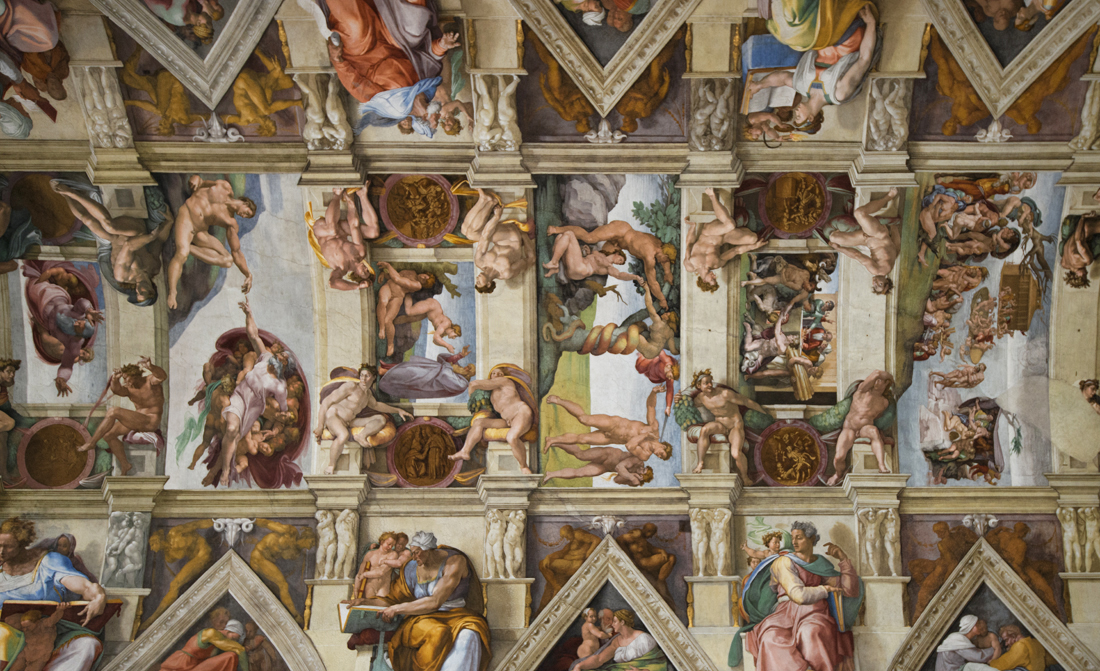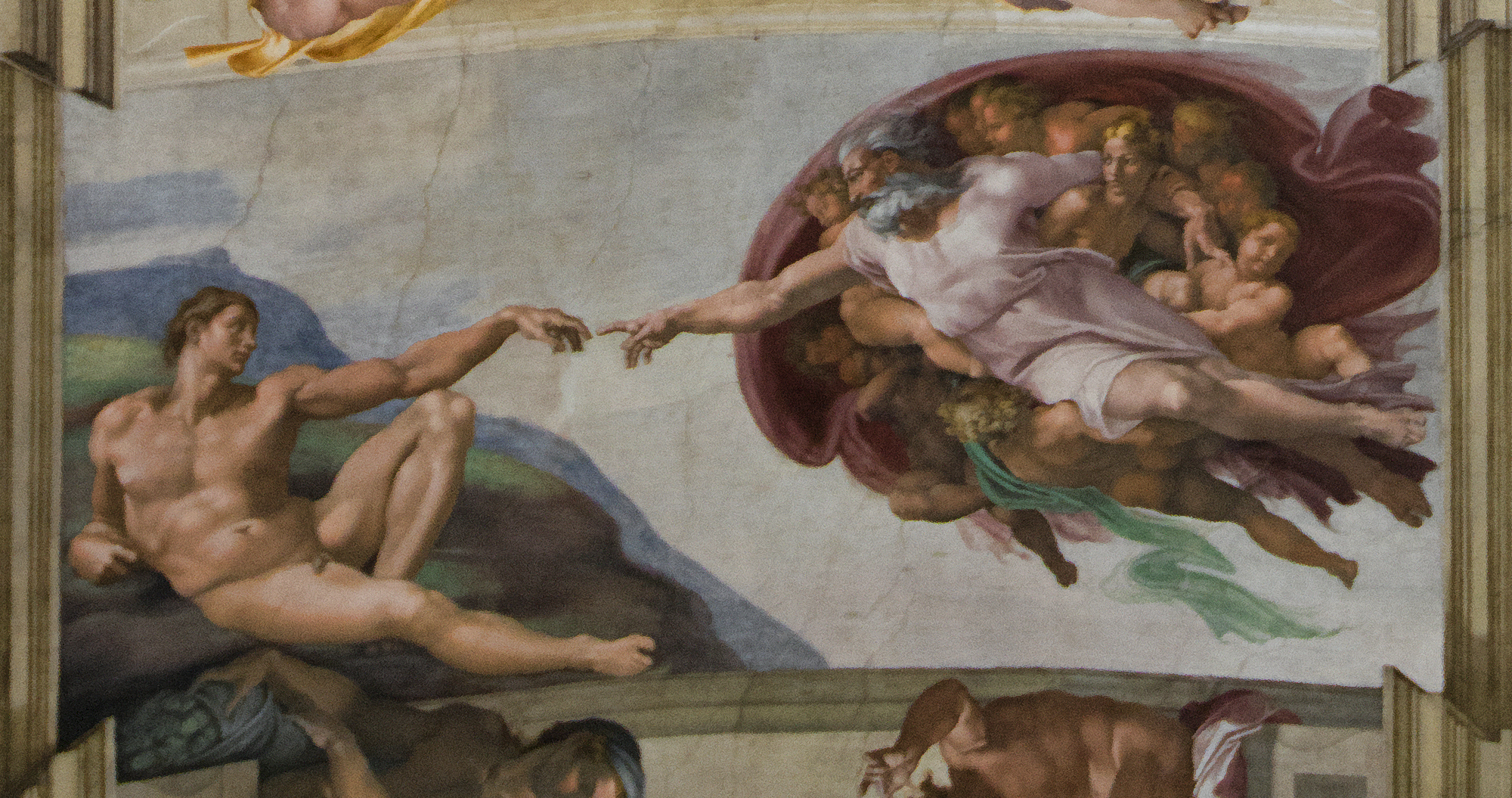Once More With Feeling
Then God said, “Let Us make man in Our image, according to Our likeness; Genesis 1:26a NASB
Image/likeness – Michelangelo’s ceiling artistry is arguably the most famous painting in the world about the creation of Man. It’s magnificent, isn’t it? But have you ever thought about what it communicates? Let’s consider the meaning behind the media.
First, a view of a large portion of the ceiling in the Sistine chapel in the Vatican. See if you can recognize the progression in the painted stories from the creation of Adam to the flood.

Now look at the creation account we want to consider. Notice the representation of God and Adam. What implications are involved? Yes, we know that this image of God as an old man is sheer idolatry, a violation of the second commandment. That it is prominently displayed on the ceiling of a holy chapel in Christianity’s theological center says quite a lot. But, for the moment, ignore this fact and concentrate on Adam. The painting shows Adam as a fully-formed human being prior to the divine touch that initiates his life. Furthermore, there is no attempt to capture the biblical idea of breathing life into the man. What this painting shows is an entirely Greek idea that Man is Man because he contains a divine spark, imparted to him from God. Notice that God is clothed and surrounded by fat little cherubs and other figures that all appear entirely human. Conclusion: heaven already contains human-like creations (angels?) who surround God in some kind of place fully contained apart from the world of Adam. Plato’s dichotomy—the separation of heaven and earth—is in full view. God is outside of our world. Only the tip of His finger manages to connect Him to us, and even that has a tiny separation. God is definitely not in our environment.

Forget the obvious fact that Adam and God are ethnic white, Northern Europeans. That’s nothing more than Michelangelo’s cultural bias in a world where the Jewish origins of Scripture were suppressed. Notice the theological implications. This painting is not about the Genesis account. It is about the Greek philosophical representation of the Genesis account. And it is the most famous representation of what it means for God to create Man.
We often are unaware of the subtle influences in our cultural history that actually shape how we see the world. We are much more the products of subconscious constructions than we are of deliberate choices. Michelangelo’s painting is an example of this cultural subconscious manipulation. How many more of our ideas about human existence and biblical themes are really the products of Western culture rather than Semitic Scripture?
Topical Index: Michelangelo, Sistine Chapel, Adam, creation, Genesis 1:26




Hi Skip.
When I read “God in some kind of place fully contained” and saw that container.. it only reminded me of a brain… as if God is a human mind elaboration…
And I wasn’t wrong… I googled “michelangelo as a scientist” and voila!
http://theartinscience.blogspot.com/2010/09/michelangelo-secret-scientist.html
wow …deification of human intellect is an end game for our adversary who wills we ignore our creator and bow to him. IF he can’t get us to worship him worshiping ourselves nets the same eternal results.
The time has not yet come for either Michelangelo or us.
Neither Greek or Hebrew has been shown the whole picture.
As Paul duly notes: “For now we see in a mirror, dimly, but then
face to face. Now I know in part, but then I shall know just as I am known.”
We know God’s Word moves us from the mind to the heart.
That’s just the beginning —- great expansion on the way!
Skip, I have wondered how much of ‘our’ Greek heritage was also infecting the Jews of the time, and how much of it we actually were taught BY them.
According to 119 Ministries (halleluah! they are now offering FREE access!) blog of November 1’s article titled Ancient Library Of Alexandria the chief librarian of the library in Yeshua’s time was Jew named Philo Judeaus who, according to the article, essentially invented the Greek classical approach to (Jewish) philosophy that was later copied by one of his successors as librarian (@ 150 C.E.), the Stoic philosopher Pantaenus, (who had converted to Christianity) and who subsequently handed the position over to Clement.
The Jews seemed to be neck and neck with the Christians of this era as to who could be more Greek!
Yes, there are deep roots here too. Lots more to look at. It will take awhile.
It’s an interesting endeavor to read the gospels in light of Yeshua, in all that he was saying, attempting to call the rulers and people back to a “biblical” purity and to remove themselves from this very thing. (Greek influence) but Greek is just another form of Babylon, edom, Rome, etc. He still calls accordingly today. While there may be a lot of differences in opinion of who the Messish was, i think we can all agree that first and foremost, he was a purist.?
OK, I get the importance of Hellinism in the evolution of Judaism, but how much damage was already done to the battered collective idenity of the captured Jewish people by the Babylonians (586 -516 BCE) through their pagan and occultic religion? Rabbic Judaism and the roots of Kabbalah can be traced to this 70 year period of occultic influence and those branches are very much alive today in Jewish thought, culture and expression. Is it fair to say that the Judaism that we see today went through so many changes, adaptations and additions from the varied cultural settings they found themselves in that there is no longer a “pure Abrahamic” expression of the original that was given to the Patriarchs? After filtering the religious memes of the Jews through the unclean sieves of Babylon, Persian, Medes, Greek, Roman, European, Russian, Polish, Ottoman cultural influences perhaps what we know of Judaism today is best captured by words of Dorthy: “Toto, I have a feeling we aren’t in Kansas anymore”. If that is the case then we have to say, along with Simon Peter: “Lord, to whom shall we go? You have the words of eternal life.”
Good point. Many times those of us who are attempting to follow the first century Messiah are accused by Christians of falling back “under the Law” or becoming Jewish. This, of course, merely demonstrates the ignorance of the objector. But now we should see that Judaism today is also not the Judaism of Yeshua’s time. As a result, perhaps we should strive all the more to understand how Yeshua viewed his Scriptures. And, by the way, how he viewed Scripture was still influenced by those hundreds of years of cultural influences.
Perhaps we are really just making a choice to follow some pattern, some paradigm, that makes sense to us now, despite its history, without becoming so enamored that the history is no longer important.
Every time I am made to feel somehow out of step for my “messy-antics” I must remember Mathew 7:21-23
I wonder, often, if what we perceive as Yeshua’s “view” of scripture isn’t so much of how He understood it as much as, perhaps, it was His attempts at connecting with the people according to how “they” understood it. Along with a number of other examples, the fire of hell would be a good example. Did He believe as they did, or was He speaking to their understanding in order to bring them to a place of understanding? I believe it was to Peter that He stated that He had much to say to him, but that he wasn’t ready to bear it. (yet?) It’s not wise to give a person more than they can bear at the moment, it causes pain and decreases the will to carry on. A little here, little there…..